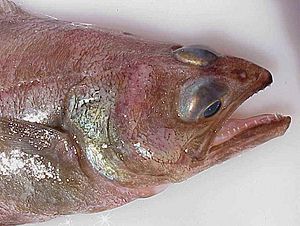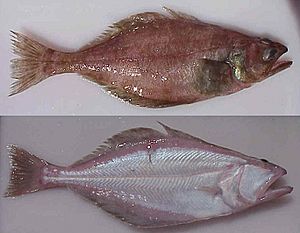Arrowtooth flounder facts for kids
Quick facts for kids Arrowtooth flounder (Atheresthes stomias) |
|
|---|---|
 |
|
 |
|
| Scientific classification | |
| Synonyms | |
|
The arrowtooth flounder (Atheresthes stomias) is a type of flatfish. It belongs to the Pleuronectidae family. These fish are found in the cold waters of the Pacific Ocean. They are especially common in the Gulf of Alaska.
Contents
About the Arrowtooth Flounder
The arrowtooth flounder gets its name from its unique teeth. These teeth are shaped a bit like arrows. They help the fish catch its food. This flounder is a very common fish in some parts of the ocean.
Where Do They Live?
Arrowtooth flounders live in the northern Pacific Ocean. You can find them from the Bering Sea all the way down to Santa Rosa Island, California. They are especially common in the Gulf of Alaska. In fact, they are the most common fish there right now.
How Long Do They Live?
Scientists are still learning about many things about the arrowtooth flounder. For example, they don't know exactly when these fish become adults. They also don't know their exact size when they are fully grown. However, we do know that these fish can live for a long time. Some arrowtooth flounders have been found to live up to 27 years!
Life Cycle
Arrowtooth flounders lay their eggs, a process called spawning, during the winter months. This usually happens from December through February. The young fish then grow and develop in the ocean.
Why Are They Special?
Arrowtooth flounders have a unique challenge. Their meat can become very soft when cooked. This happens because of a tiny parasite that lives in the fish. This parasite releases a special chemical, called an enzyme. When the fish is heated, this enzyme makes the meat mushy. This can make the fish less valuable for selling.
To solve this problem, scientists and fishermen have found ways to treat the fish. They use special additives that stop the enzyme from working. This helps the meat stay firm when cooked. Because of these new methods, arrowtooth flounder can now be sold more easily. On the West Coast, it is often sold as "turbot." However, it is not actually related to the true turbot fish.

